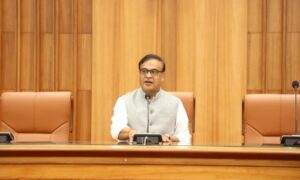
File Picture
The sudden outbreak of violence on the 22nd Nov last at Mukroh, a village in Karbi Anglong district of Assam along its border with Meghalaya in karbi Anglong – West Jaintia Hills sector that began with detection of an illegally felled” timber laden truck” by the Assam Police and Forest guards provoking violent resistance of the khasi villagers to the same that caused 6 lives including an Assam Forest guard and 5 khasi Jaintia men took the administration of both the states by surprise for good reasons: First,talks to resolve the simmering Assam Meghalaya border problem in 12 sectors of which 6 have been amicably settled are still continuing at the level of two Chief Ministers when the violence took place: Second, the violent way the Khasi villagers reacted to the action of the Assam Forest and Police after seizure of the truck in Assam territory took the local Assam authorities by surprise. The allegations of the khasi villagers that vehicles carrying rice were seized actually and that the police action was excessive and thus a case of human rights violation cannot be ignored : Third, this is the first instance in the North East of armed clash involving two Sixth Schedule Areas – Karbi Anglong of Assam and West Jaintia Hills of Meghalaya and that too involving Karbi Anglong district which for years has been facing ” insurgency “movement demanding a seperate state of Karbi Anglong the significance of which must be duly noted as it adds a new dimension to the border issue. This was evident from the report carried by Jorhat based Assamese daily Dainik Janambhumi in its last Dec 3 issue that on December 1, The Chief Executive of Karbi Anglong Autonomous District Council Tuli Ram Rongkhor, Local MLA R.S.Teron reportedly asserted that there was no illegal occupation in Mukhrow ( also spelt as Moikrang in Khasi). More significantly they referred to a 500 year old treaty signed between the Karbi Veer Mankar and the Khasis that ensured peaceful coexistence of the Karbis and the Khasis. This is a clear signal to Assam and Meghalaya that the Karbis have stakes in the matter and should be taken on board on the ” border issue” eve when the facts suggest that there’s no “border problem” in this area for the following reasons:
First, unlike United Khasi and Jaintia Hills district, the Mikir Hills district which was renamed Karbi Anglong district after April 1 1995 Karbi Accord between Govt of India,Govt of Assam and tribal bodies of Karbi Anglong and North Cachar Hills was formed after independence by grouping the North Cachar Hills subdivision of Cachar district and Mikir inhabited hill areas of districts such as Nowgong and Sibsagar as the United Mikir and NC Hills district and was included in Part A of districts under the Sixth Schedule as first enacted.It must be noted that seperate tribal identities of were recognised as the areas were listed at sl 5 and 6 to constitute separate Autonomous District Councils in Mikirs and Dimasa and other tribes in the N.C. Hills.The two Mikir inhabited blocks which were included in the Khasi and Jaintia Hills district under 1935 notification continued to remain so till the grant of full statehood to Meghalaya under the North Eastern Areas Reorganization Act 1971 when these blocks were transferred back to Mikir Hills Mukhrow is located in this segment. There was thus no border issue though cross border illegal felling of Pine trees has been a long standing problem for the local administration.
From an objective point of view, however , more than the violence at Mukro ,the perception that despite all the restrictions on land use and ownership , forests and minerals under the Sixth Schedule of the Constitution to protect the rights of the tribals and their way life founded on customary laws are being violated at will by powerful interests in Meghalaya and adjoining areas of Assam – mostly by tribal elite is widespread. Equally common is the perception that a defacto ” privatisation of community resources” has taken place which created an unsustainable “extractive economy”. Meghalaya already appears to be a text book case of ” resource curse theory” in practice as her vast forest and mineral resources didn’t really trigger any growth momentum as only a small section of tribals have become rich and powerful. This indeed is the real issue and not any ” border dispute”. In fact illegal felling of pine trees and mining of coal and sand for” profits ” in clear violation of the provisions of the Sixth Schedule which allow only mining for domestic use has been going on for years in Meghalaya and adjoining Sixth Schedule areas of Assam the repeated orders and observations of the National Green Tribunal not withstanding. Experience suggests that the existing arrangement dual control over forests in Meghalaya , that is, the state Forest department in charge of the “Reserve Forests”only while the subject of ” the management of any forest not being a reserved forest” is included under para 3 of the Sixth Schedule detailing the powers of the District Councils and Regional Councils to make laws . This dual control has been causing steady deforestation as illegally felled trees and other forest produce in Reserved forests could be easily passed on as timber from the private or community forests for use in plywood industry and even taken out of the region by manipulating records with the connivance of the concerned staff of both the state and the District Council.
This ground reality cannot be ignored by the Centre any longer because the subject of Forests is in the Concurrent list of the Constitution, and its continuance will cause irreparable damage to ecology and environment of the region and render climate change mitigation strategy and action plan meaningless in the North East . Further, its adverse effect on the ecology of Bangladesh might create problems in our relations with Bangladesh and even Myanmar.
Thus a discerning observer of post Mukroh violence might look at it as unfortunate and avoidable while underscoring the continuing failure of ” forest and environmental governance” for which not only the two State authorities but also the Union Ministry of Forests Environment and Climate change cannot avoid responsibility.
Nevertheless the Mukro violence has provided an opportunity for the Centre, NE States, the North Eastern Council, Department for Development of the North East India and Niti Ayog to give a hard look at the role of the Autonomous District Councils in Assam , Meghalaya, Tripura and Mizoram in broad area of conservation of ecology and to put in place an integrated system of environmental governance which could only prevent recurrence of the kind of violence that took place at Mukroh. Thus there is strong evidence that the cause of Mukro violence was not a dispute over the border but continuing failure of forest and environmental governance in the North East.
( The author a former IAS officer of Assam Meghalaya cadre had also served as a Scientific Consultant in the office of the Principal Scientific Adviser to the Government of India).
[the_ad id=”55725″]


















